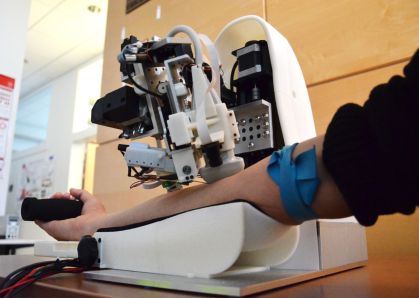Robot Uses Artificial Intelligence and Imaging to Draw Blood
Rutgers engineers create device that can also insert catheters

Rutgers engineers have created a tabletop device that combines a robot, artificial intelligence and near-infrared and ultrasound imaging to draw blood or insert catheters to deliver fluids and drugs.
Their most recent research results, published in the journal Nature Machine Intelligence, suggest that autonomous systems like the image-guided robotic device could outperform people on some complex medical tasks.
Medical robots could reduce injuries and improve the efficiency and outcomes of procedures, as well as carry out tasks with minimal supervision when resources are limited. This would allow health care professionals to focus more on other critical aspects of medical care and enable emergency medical providers to bring advanced interventions and resuscitation efforts to remote and resource-limited areas.
“Using volunteers, models and animals, our team showed that the device can accurately pinpoint blood vessels, improving success rates and procedure times compared with expert health care professionals, especially with difficult to access blood vessels,” said senior author Martin L. Yarmush, Paul & Mary Monroe Chair & Distinguished Professor in the Department of Biomedical Engineering in the School of Engineering at Rutgers University–New Brunswick.
Getting access to veins, arteries and other blood vessels is a critical first step in many diagnostic and therapeutic procedures. They include drawing blood, administering fluids and medications, introducing devices such as stents and monitoring health. The timeliness of procedures can be critical, but gaining access to blood vessels in many people can be quite challenging.
Failures occur in an estimated 20 percent of procedures, and difficulties increase in people with small, twisted, rolling or collapsed blood vessels, which are common in pediatric, elderly, chronically ill and trauma patients, the study says. In these groups, the first-stick accuracy rate is below 50 percent and at least five attempts are often needed, leading to delays in treatment. Bleeding complications can arise when major adjacent arteries, nerves or internal organs are punctured, and the risk of complication rises significantly with multiple attempts. When nearby blood vessels are inaccessible, more invasive approaches such as central venous or arterial access are often required.
The robotic device can accurately steer needles and catheters into tiny blood vessels with minimal supervision. It combines artificial intelligence with near-infrared and ultrasound imaging to perform complex visual tasks, including identifying the blood vessels from the surrounding tissue, classifying them and estimating their depth, followed by motion tracking. In other published work, the authors have shown that the device can serve as a platform to merge automated blood-drawing and downstream analysis of blood.
Next steps include more research on the device in a broader range of people, including those with normal and difficult blood vessels to access.
“Not only can the device be used for patients, but it can also be modified to draw blood in rodents, a procedure which is extremely important for drug testing in animals in the pharmaceutical and biotech industries,” Yarmush said.
The lead author is Alvin Chen, who earned a doctorate at Rutgers. Co-authors include Max L. Balter and Timothy J. Maguire, who also earned doctorates at Rutgers, all under the supervision of Yarmush.


